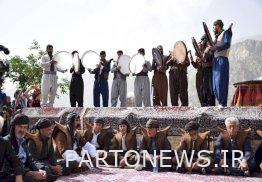Kumsai ritual ceremony in Horaman

Kumsai in Horami consists of the two words “ku” meaning gathering and assembly and “masai” meaning learning.
This ceremony, after a break of several years due to the spread of the infamous Corona virus, was held in the presence of a large number of tourists from inside and outside the country, in the area adjacent to the shrine of Seyyed Mustafa known as Pirshalyar, a descendant of Imam Jafar Sadegh. held.
Accordingly, the people of Horaman region went to the place of Kumsai ceremony on the morning of Friday, May 6, 1401, to commemorate and perform this ancient ritual.
The ceremony began with the recitation of the Holy Quran and the speech of Imam Juma Horaman, and continued with the recitation of ode and burial.
It is narrated that due to the special situation of the region and the culture of cooperation and coexistence originating from the harsh nature of Horaman and the culture of nomadism and nomadism, every year in the middle of spring people leave the village and migrate to near and far summers in the region. They were separated from each other for a year, and before moving and separating from each other, they found it necessary to organize rules in meetings and ceremonies, to divide the necessary social affairs among themselves, to leave them to qualified people, and to prepare for migration.
Behind this story, a legend is narrated that Pirshalyar was a noble man and had special miracles, for example, it is said that he was able to heal Shah Baharkhatun, who was a deaf and dumb girl.
The story goes that the king of Bukhara had a deaf and dumb girl whom all the doctors were unable to treat, so the king and the courtiers went to Pirshalyar so that he might be able to heal the girl. When the king and his daughter get close to Horaman, the girl gains her hearing, and when they get close to Pirshalyar’s house, the girl opens her mouth after the sound of Devi’s scream is heard; At the end of the story, the king’s daughter and Pirshalyar get married and a big wedding party is held for them, which is the anniversary of Kumsai.
There are also narrations that one day one of Pirshalyar’s disciples named Darvish Gomar went to Pirshalyar and complained about the lack of milk of his cattle. Close to increase their milk. For this reason, at the end of the Kumsai ceremony, they still break the white stone near the Pirshalyar shrine and take it with them for blessing, which according to the people of Horaman, has a blessing property.
Fans take part in this ceremony every year to cut small pieces of this relatively large stone by cutting other pieces of stone. It is noteworthy that whatever is broken and separated from this stone in Kumsai ceremony, it grows again next year And it never ends.
The establishment of an exhibition of handicrafts by artists of this region was another side program of the traditional Kumsai ritual ceremony in Horaman Takht, which was presented in the form of 15 booths.
Accordingly, Kumsai can be considered as a symbol of the beliefs and beliefs of the people of Horaman region, a ritual that dates back to more than a thousand years ago according to documented documents as well as the traditions of trustees and elders of the region.
Horaman Takht city is located 60 km south of Marivan city and west of Sarvabad city with a population of more than 3500 people among the towering mountains of Takhtoshani, Pir Rostam, Malhasab and Kosalan. It becomes.

